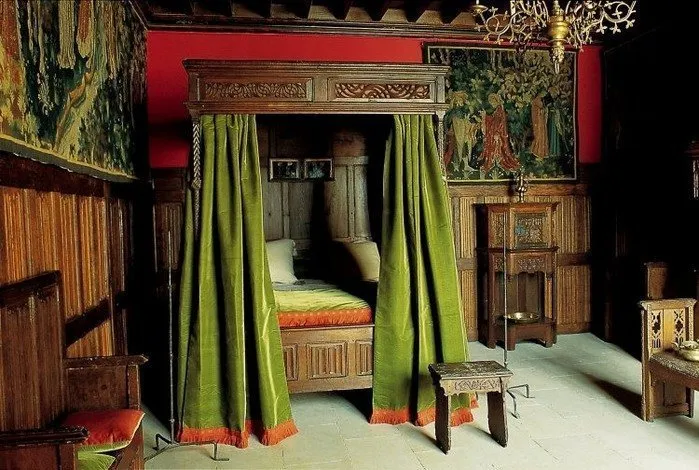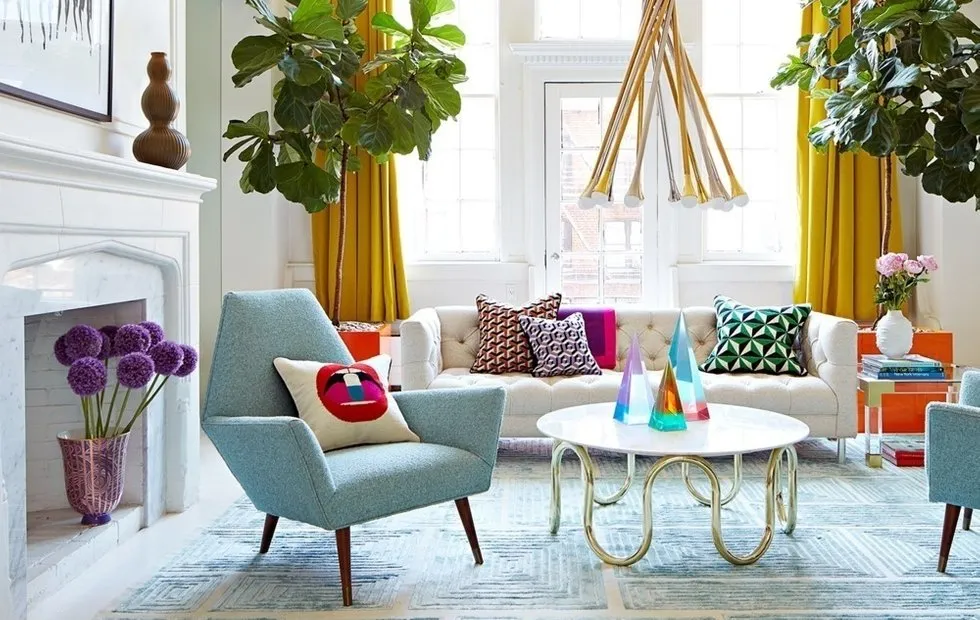There can be your advertisement
300x150
The Shortest History of Interior Design in 40 Pictures
We tell the story of furniture: from the first chair in Egypt to the opening of the IKEA store
The entire history of industrial and interior design would barely fit into two or three books. We decided to simplify your task by selecting the most interesting and important historical events related to furniture and interior design.
3000 BC — Ancient Egyptians invented the first chair
And also the first table and bed. By the way, on ancient drawings of chairs, you can see simple chairs with straight legs and backrests and cushions to soften the seat. That means comfort was already considered at that time.
Chairs were made from wood. And for particularly wealthy people, they used elephant ivory, inlay, and leather as decoration.
Around 500 BC — The first teakettle appeared
In Ancient Rome, it was called an autopsa. The principle of operation has not changed since then: inside the vessel is a hearth where combustion occurs. Water is poured into this vessel to heat it up.

Autopsa from Ancient Rome
10–12th century AD — The bed took its modern form
A bed similar to the modern one appeared in the early Middle Ages. Starting from the 12th century, in wealthy homes, canopies were added as protection against cold.

17th century — In Italy, the chest of drawers became a credenza
Initially, it was a special table with two legs that leaned against the wall, where food was tested for poisoning before serving. Later, the credenza gained a second level and doors and settled not only in dining rooms but also in living rooms and dressing rooms. Essentially, it was a prototype of the modern wardrobe.

1672 — Andre-Charles Boulle received the title of royal cabinetmaker
Perhaps Andre-Charles Boulle would have remained just another talented but little-known furniture maker if he hadn’t been at the court of Louis XIV. Today, his works in the marquetry technique (inlaying furniture with drawings from valuable wood species) are exhibited in major museums worldwide and sold for exorbitant prices.
1790 — The mirror-psyche entered the composition of a lady’s dressing table
A rectangular or oval wooden frame of the mirror-psyche was attached to the table, chest, or base in the style of a drawing board using two rods with hinges. In Russia, the trend towards these mirrors started with the help of German master Gambus.

1851 — The first World Exhibition of Industrial Works took place in London
Its organizers were Prince Consort Albert and artist-craftsman Sir Henry Cole. The exhibition gave not only a boost to the development of architecture (just consider the Crystal Palace built for it), but also contributed to the creation of a system for training craftsmen in decorative and applied arts.

Main Pavilion of the Exhibition
1857 — The Art Museum opened in South Kensington
Today, no one is surprised by art museums, but at that time it was a breakthrough. The museum gave rise to a school of artistic design (design). Today, they are known as the Victoria and Albert Museum and the Royal College of Art.

One of the Halls of the Victoria and Albert Museum
1869 — Michael Thonet invented and patented the industrial method of wood bending
This allowed assembling a chair from only six parts — thus the famous Vienna Chair was born. Elegant design and new cost-effective technology made it legendary. By 1930, about 50 million chairs had been sold worldwide.
1895 — Tiffany & Co. released the first lamp
While in Europe, the era of Art Nouveau (Art Deco, Jugendstil) dominated, in America Charles Lewis Tiffany experimented with glass design. The result was a unique technique of joining colored glasses using copper wires. Lamps in this technique are among the most expensive in the world today. For example, for the “Pink Lotus” lamp (1907) at Christie’s auction, $2,800,000 was paid.

1919 — The Bauhaus Higher School of Construction and Design was opened in the German city of Weimar
The idea behind founding the school was to bring learning as close as possible to production. Students were not supposed to create some autonomous item, but rather a product that could be manufactured industrially.
Barcelona Chair, Ludwig Mies van der Rohe
Stacking Tables, Josef Albers
Vasily Chair, Marcel Breuer
Kettle, Marianne Brandt
1925 — Alexander Rodchenko exhibited the design project of the Workers' Club in Paris
Alexander Rodchenko, who taught at VITEPS (Vysokaya Shkola Upravleniya i Tekhnologii), used in the club project durable columnar beam systems — in the design of chairs, tables, and shelving partitions. But they were not as simple as they seemed — all of them were transformers.

1952 — Le Corbusier designed the first concrete lamp
Yes, the idea of making lamps and furniture from concrete belongs to Le Corbusier. The Borne Béton model was developed for lighting the outdoor area of the Marseille “Housing Unit,” one of the most famous architectural projects by Le Corbusier. But it would also fit perfectly into a modern loft.

1945 — Earl S. Tupper invented a plastic food container
The prototypes of all food containers created by Tupper revolutionized the industry. Light, beautiful, and convenient to use — in 1947, the popular magazine House Beautiful even called them a work of art.

1950 — The Eames Plastic Armchair was presented at the MoMA competition
Innovative for its time, the chair with metal legs and a seat and back made of colored mass-produced polypropylene is now overexposed to designers. Too many replicas.

1955 — Eero Saarinen showed that a chair does not need four legs to maintain balance
His Tulip Chair became one of the most sold furniture models. Indeed, it was also the most counterfeited.

1958 — The first IKEA store opened in Sweden
It is unlikely that the founder of the company IKEA, Ingvar Kamprad, imagined that recognizable IKEA items could be found from a loft in New York to a studio apartment in Moscow by 2018.

Ingvar Kamprad
1961 — The first Salone del Mobile Milano exhibition took place
On the Fiera Milano premises, with 328 participants and 11,300 visitors from Italy and 800 from abroad. Over the years, the international significance of the exhibition increased, as did the export of Italian furniture — thus, the idea worked.

1962 — Achille Castiglioni created a lamp for the Italian factory Flos
Which became one of the most recognizable in the world. Of course, it is the Arco model with a marble base. It is said that the author tried to recreate the silhouette of a street lamp.

1969 — Gaetano Pesce finished working on the UP chair series
The designer’s form was inspired by the female body. And, of course, no one remained indifferent. In 2000, the company V&B Italia bought the author's rights to the UP series from Gaetano and started manufacturing chairs under the name UP 2000.

1976 — Alessandro Gurschi created the “Alchemy” studio
As a gallery of experimental works not intended for industrial production. A mix of popular culture and radical kitsch — that's how you could briefly describe the style in which the artists worked.

1981 — The “Alchemy” studio’s daughter group, “Memphis,” appeared in Milan
The Memphis style became a true anarchy in design. One of the favorite materials for designers was laminate, which they valued for its “lack of nobility.” They used collages built on the principle of chaos, and many objects looked like children’s toys.
Kristall table, Michele de Lucchi
Carlton-cabinet, Ettore Sottsass
Casablanca bookcase, Ettore Sottsass
Superlamp, Martina Bedin
1984 — Philippe Starck created the interior of Café Costes in Paris
A chair made of wood and metal, designed for the café, enjoyed such enormous popularity that by 1990, the number of copies made exceeded four hundred thousand.
This was only the beginning of the designer’s career. Today, the whole world knows Philippe Starck as the author of the legendary Louis Ghost chair, the first Microsoft computer mouse, and the designer of the most prestigious hotels in the world.

1988 — Antonio Citterio began working with the company Vitra
Unlike the group “Memphis,” Antonio Citterio promoted simplicity and quality. He also placed great emphasis on ergonomics. The result of his work was the Visavis chair: it adjusts itself to the weight of the person sitting.

1993 — The Droog Design studio officially opened in Amsterdam
And immediately released, probably, the most famous lamp of its own — 85 Lamps. Its developer Rodi Graumans brought together 85 bulbs and suspended each one on a black wire. Many designers still use this idea to this day.

1995 — The first Maison & Objet exhibition took place
Maison & Objet features everything from textile products and soft furnishings to Christmas ornaments. Some call Maison & Objet the center of Parisian creativity, others attribute to it characteristics of a modern art museum. Designers rush to participate in this event every year.

2001 — Marcel Wanders founded the company Moooi
The name of the company is a play on the Dutch word “mooi” — beautiful. The third letter “o” is added for effect: it becomes “nu o-o-very beautiful!” Bold ideas, original design, unexpected use of materials, and healthy irony — these are the signs by which you can identify Moooi products.

Moooi Gallery in Amsterdam
2009 — Vitra presented the Vegetal chair
Its authors are the French duo Ronan and Erwan Bouroullec, who were inspired by nature itself. The development of the item took four years, and the seat, backrest, and armrests are made from flat metal strips that resemble leaf veins or tree branch interweaves.
2018 — Experts at Maison & Object named Sissi Manz the Designer of the Year
Sissi Manz believes that Scandinavian design should be based on the real life of Scandinavians. “People in the north strive for economy, and this is reflected in classical Danish design,” explains Manz. “My works are also minimalist because I try to limit them to only what is absolutely necessary.”

Mikado table enters the permanent collection of the Museum of Modern Art (MoMA) in New York.
It's interesting that among the historical diversity of styles, forms, and decorative techniques, modern designers increasingly focus on the minimalist appearance and functionality of items. Natural materials, forms inspired by nature, and maximum comfort — trends that we will observe in the coming years.
More articles:
 Architectural Biennale: Why You Should Buy Tickets to Venice Now
Architectural Biennale: Why You Should Buy Tickets to Venice Now Apartment with Mini-Kitchen and Loft Bedroom
Apartment with Mini-Kitchen and Loft Bedroom How to Beautifully and Budget-Friendly Decorate a Cottage: Real Example
How to Beautifully and Budget-Friendly Decorate a Cottage: Real Example How to Pay Less for Water: Choosing the Right Plumbing Fixtures
How to Pay Less for Water: Choosing the Right Plumbing Fixtures How to Make a Bright Living Room: Designer Tips
How to Make a Bright Living Room: Designer Tips 15 Design Solutions That Are Hopelessly Outdated
15 Design Solutions That Are Hopelessly Outdated 5 Ideas on How to Decorate Your Apartment: Shopping with Marina Svetlova
5 Ideas on How to Decorate Your Apartment: Shopping with Marina Svetlova 12 Ways to Cool Down Your Apartment Without Air Conditioning
12 Ways to Cool Down Your Apartment Without Air Conditioning